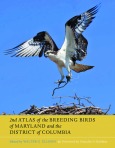Wild Thing is an occasional series where JHU Press authors write about the flora and fauna of the natural world—from the rarest flower to the most magnificent beast.
Guest post by Walter G. Ellison
Anyone leafing through the recent Second Atlas of the Breeding Birds of Maryland and the District of Columbia might notice that most of the birds that nest in Maryland and D.C. do not reside at their breeding sites year round. Most migrate in winter to a distant land, but it is only a small minority of our nesting birds that are actually sedentary. Even many of those that do winter locally do not winter where they nested. For instance, Maryland’s breeding Dark-eyed Juncos nest at high elevations in Garrett County but winter at lower elevations downslope and mostly to the south and east of Garrett County.
Each bird’s biology varies with its evolutionary history, so there are as many migrations as species. Indeed, there is also much individual variation in migration within species. A small number of Gray Catbirds winter annually in Maryland, mostly on the Coastal Plain, but the vast majority winter in southern Mexico and Central America.
Nonetheless, we can broadly divide temperate migratory birds into two classes: short-distance migrants that winter in warmer parts of the temperate zone (at least warmer than where they nest) and long-distance travelers to the tropics. When early spring is warm, as it was in March of 2012, these two broad classes of migrants respond very differently to the early spring weather.
Temperate wintering birds are on the same land mass as the early spring weather and respond quickly to the predominant southwesterly winds that bring early spring warmth. So birds such as Tree Swallows and Eastern Phoebes may arrive up to a month ahead of their median long-term arrival date in warm early springs. On the other hand, birds wintering in the tropics have no indication of unusual weather north of the Tropic of Cancer. Long-distance migrants appear to rely on poorly understood inborn cues for when to start spring migration more than any obvious external climatic information; local day length in the tropics may have something to do with it.
Despite much optimism among birders seeking their summer favorites among the first migrants of the season, it is highly unlikely for long-distance tropical migratory birds to arrive much more than a week earlier than their long-term median arrival dates. Rarely, a tropical wintering bird may winter far to the north of its usual winter quarters and there are a few species that winter in small numbers in southern Florida and on the Gulf Coast that may arrive ahead of their fellows. These instances should be carefully documented, particularly because these records may provide early signs of changes in migratory behavior wrought by global climate change.
As the climate changes and brings early and record spring warmth on a more regular basis, it is possible our long-distance tropical migrants may be shifted out of synchrony with leaf-out and flowering of plants, and more importantly, the emergence of insects that feed on those early plants. Because most tropical migratory birds eat insects and feed them to their offspring, being out of step with the first flush of insect life in spring could affect their nesting success and survival. Only time, and well-designed research, will reveal if this is happening or if the birds instead adapt to the change despite its relative rapidity.
 Walter G. Ellison is the project coordinator of the Maryland and D.C. Breeding Bird Atlas Project at the Maryland Ornithological Society. He is the editor of Second Atlas of the Breeding Birds of Maryland and the District of Columbia, now available from the JHU Press.
Walter G. Ellison is the project coordinator of the Maryland and D.C. Breeding Bird Atlas Project at the Maryland Ornithological Society. He is the editor of Second Atlas of the Breeding Birds of Maryland and the District of Columbia, now available from the JHU Press.


